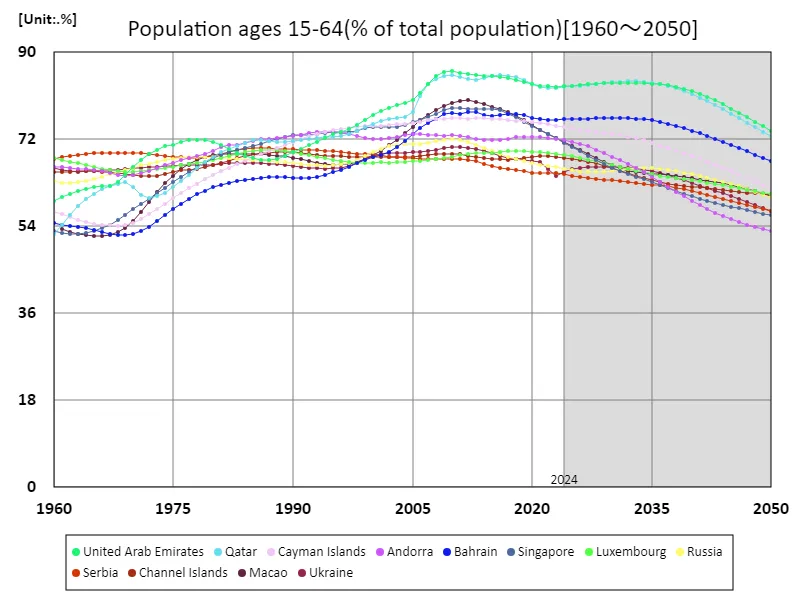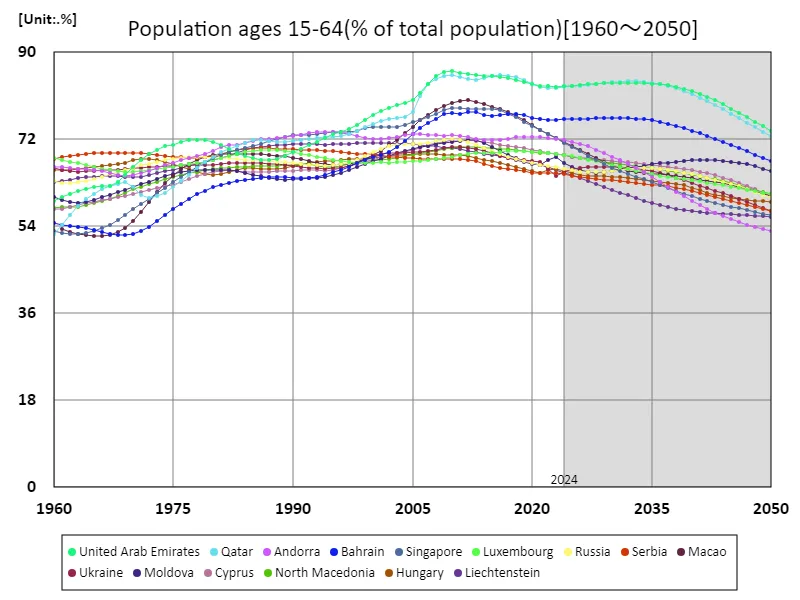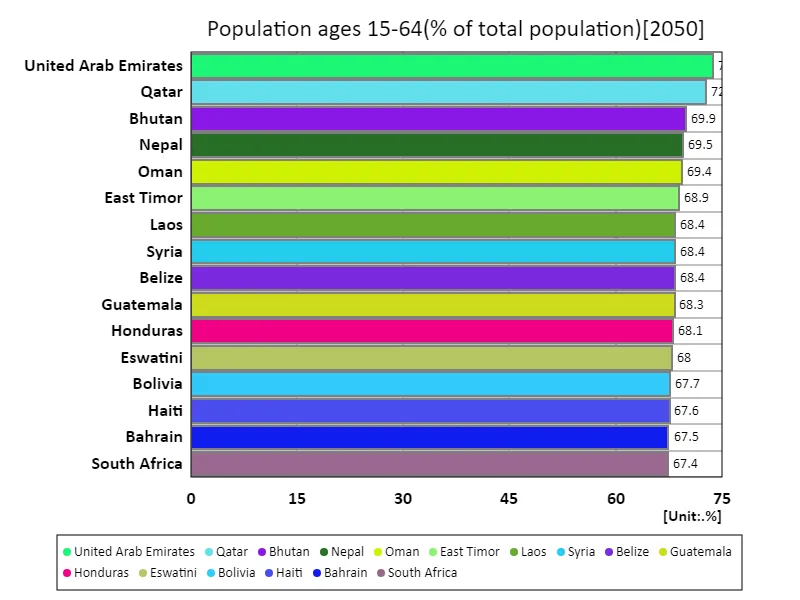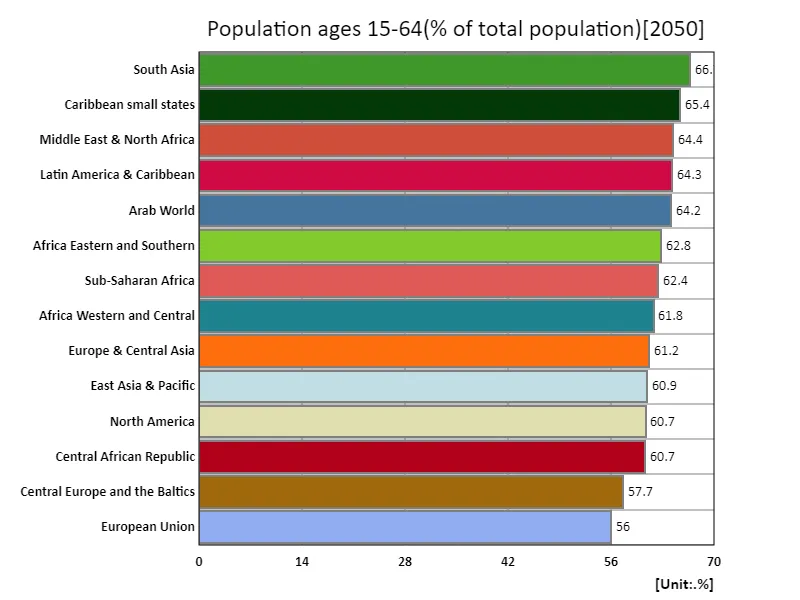Abstract
The population ratio between 15 and 64 years old is an important indicator of the number of workers and social productivity. The reason why the United Arab Emirates (UAE) is predicted to have a population of 73.8% in 2050 is due to its demographic characteristics, which include a large young population. The UAE is a rapidly growing economy, driven by a high immigration policy and economic diversification. This has resulted in a high proportion of young people in the labour market. Other factors that affect this indicator in other countries include an ageing population and declining birth rates. Overall, countries with a high proportion of young people have the potential for economic growth, but they also need to prepare for an aging society in the long term.
Population aged 15-64 (percentage of total population)
When considering the population ratio of 15-64 year olds from 1960 to 2050, we can see that the United Arab Emirates (UAE) has a unique economic and social background. The UAE recorded a high rate of 86.1% in 2010, and although it has now fallen slightly to 85.8%, it still remains at a high level. This is due to the UAE’s fast-growing economy and abundant young workforce. Since the 1970s, the country has experienced rapid economic growth with the development of the oil industry, resulting in a large influx of immigrant workers and a large proportion of the working age population. While this high ratio contributes to revitalizing the UAE’s economy, it is also necessary to take into account the high degree of dependence on the labor market and measures to deal with the future aging society. Globally, especially in developed countries, the proportion of the population aged 15 to 64 is declining due to the effects of low birth rates and aging populations, a trend that contrasts with the UAE. Like the UAE, maintaining a youth ratio in line with economic growth is important for sustainable economic development, but in the longer term it will also be necessary to adapt to an ageing population.


The maximum is 86.1%[2010] of United Arab Emirates, and the current value is about 85.8%
Population aged 15-64 (percentage of total population) (worldwide)
The population ratio of those aged 15 to 64 indicates the proportion of the labor force that is the core of economic activity, and data from 1960 to 2050 shows significant differences between regions. The United Arab Emirates (UAE) recorded a high rate of 86.1% in 2010, before declining slightly to 85.8%. This was against a backdrop of rapid economic growth and an increase in immigrant workers, resulting in a high proportion of the working age population. The UAE’s high proportion is the result of its developing oil industry and increasing economic diversification, and is characterised by a particularly large number of migrant workers. On the other hand, many developed countries around the world are experiencing a declining birthrate and an aging population, with the proportion of the population aged 15 to 64 years old showing a downward trend. This is due to a declining birth rate and an aging society. Maintaining a high ratio like the UAE’s will require economic diversification as well as appropriate measures to address long-term demographic changes.


The maximum is 86.1%[2010] of United Arab Emirates, and the current value is about 85.8%
Population aged 15-64 (percentage of total population) (worldwide, latest year)
According to data for 2050, the proportion of the population aged 15 to 64 will be highest in the United Arab Emirates (UAE) at 73.8%, compared to the average of 62.4% and the total of 12.3k%. The high ratio in the UAE is largely due to its young population, strong economic growth and acceptance of migrant workers. This high ratio reflects the UAE’s rapid economic development and expanding labor market, but in the longer term it will be challenged to respond to an ageing society. On the other hand, the global average of 62.4% is evidence of the declining birthrate and aging population. Developed countries are experiencing falling birth rates and ageing populations, resulting in a shrinking proportion of people of working age. For this reason, countries are being called upon to implement policies to secure the labor force and support the elderly. The total figure of 12.3k% is the combined proportion of the population aged 15-64 in all countries and reflects global workforce trends while reflecting differences between countries. Going forward, strategies for adapting to an aging population while maintaining economic growth will be important.


The maximum is 73.8% of United Arab Emirates, the average is 62.4%, and the total is 12.2k%
Population aged 15-64 (percentage of total population) (region, latest year)
According to data for 2050, South Asia will have the highest proportion of the population aged 15-64 at 66.7%, compared to an average of 61.6% and a total of 925%. The data shows the demographic differences across regions and the associated economic impacts. The high proportion of South Asians reflects their relatively young demographic. The region has a fast-growing economy and high birth rates, resulting in a large proportion of people of working age. However, this is only temporary, and as the population continues to age, the proportion of working-age people is likely to gradually decrease. On the other hand, the global average is 61.6%, indicating that Japan is facing a declining birthrate and an aging population. Due to declining birth rates and an increase in the elderly population, particularly in developed countries, the proportion of the population aged 15 to 64 is declining. This trend is causing slower economic growth and labor shortages, and countries need to take action. The total figure of 925% represents the overall proportion of working-age people and reflects the demographic influences of each region. In the long term, it will be important to develop economic policies and social security systems that respond to differences in population structure in each region.


The maximum is 66.7% of South Asia, the average is 61.6%, and the total is 925%



Comments